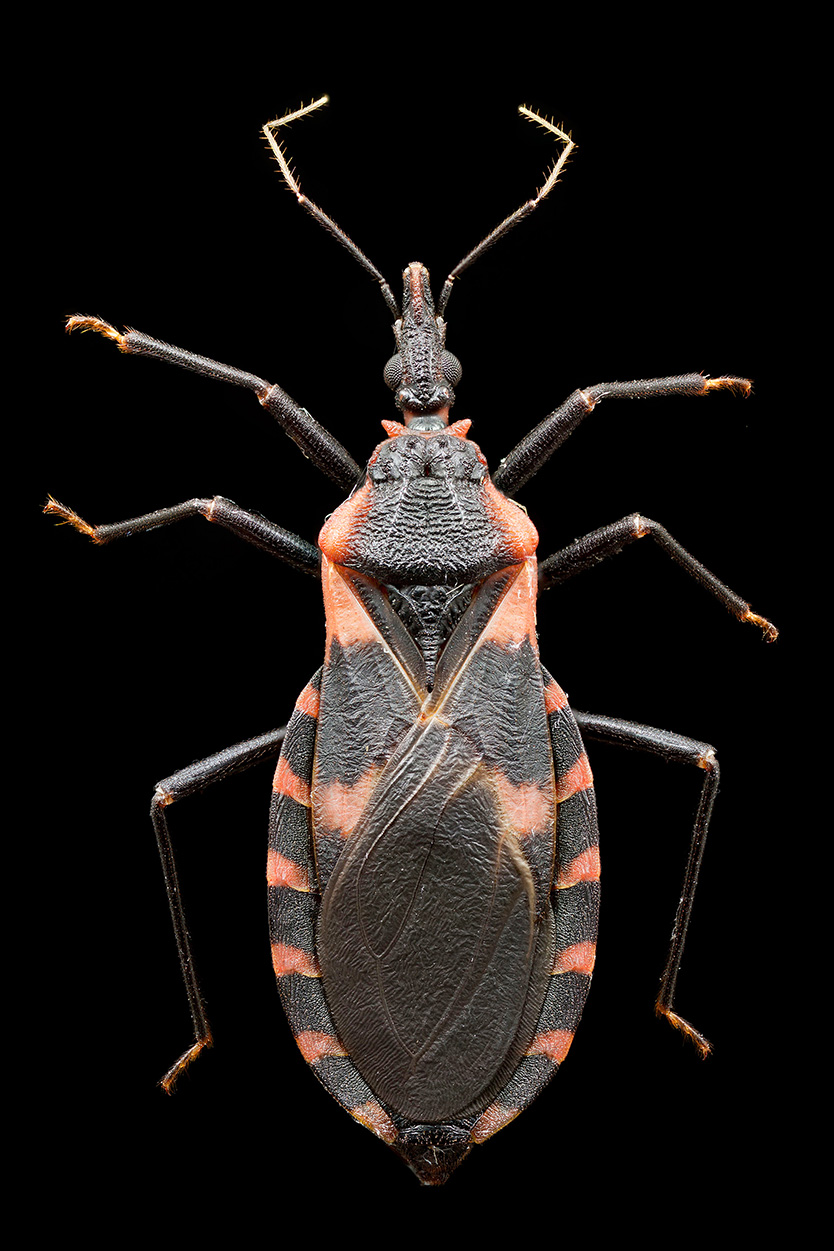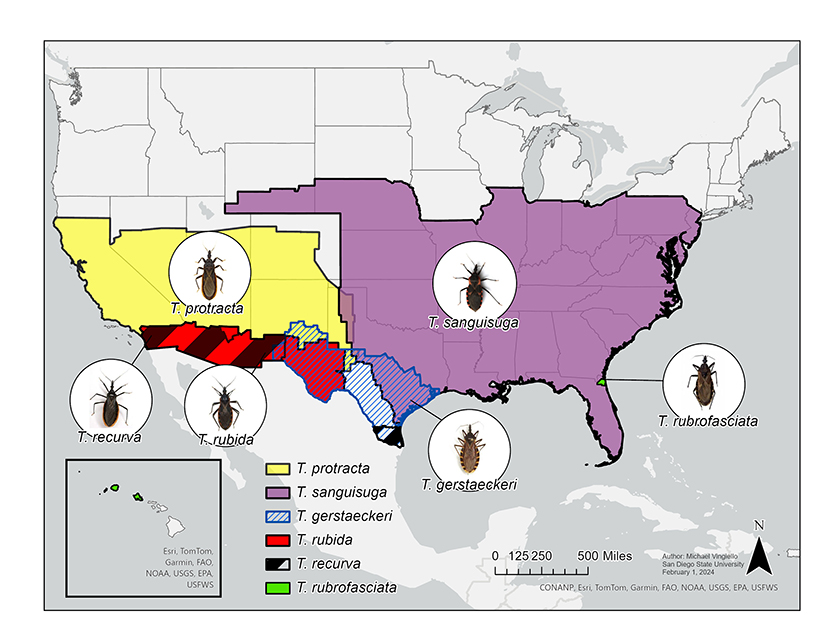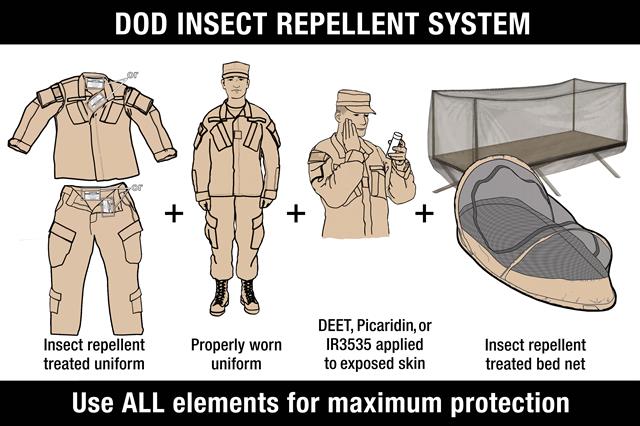Chagas Disease
Who is at risk of getting Chagas disease?
Chagas disease is a disease of the Americas. It is most prevalent where a significant percentage of people live in poor housing conditions in rural areas where humans and kissing bugs may live together in the same spaces. Military personnel training in the field within the Southern US and traveling to or deployed in areas of Latin America where Chagas disease is endemic are at risk and should take measures to protect themselves from kissing bugs. Military working dogs (MWDs) are very susceptible to Chagas disease due to the nature of their sleeping conditions and disposition to orally consume the insects.

Kissing bug
(Triatoma sanguisuga).
Photo by Graham Snodgrass

Kissing bug distribution in the US.
Image by Michael Vingiello
How do you get Chagas disease?
Chagas disease is a vector borne disease that is usually contracted through contact with the kissing bug's parasite-infected feces. Infections may occur when the kissing bug defecates while feeding and the watery feces enters the bite wound, eyes, or mouth, often by rubbing. Kissing bugs usually feed while people are asleep and often bite the face as this is an area exposed during sleep and they are attracted to the carbon dioxide in our breath. The bite is initially painless, and most people do not realize that they have been bitten. The bite site soon becomes an itchy welt that may lead to scratching and ultimately disease transmission. The kissing bug species most likely to transmit Chagas disease are adapted to living in human dwellings. They hide in cracks and crevices in floors and walls, thatched roofs, house plants, furniture, and around ceiling rafters during the daylight hours. Kissing bugs emerge at night in search of a blood meal. Humans can also acquire the parasites by eating uncooked food or drinking beverages contaminated with infected feces from kissing bugs. Chagas disease can also be contracted through blood transfusions, organ transplants, and directly from mother to unborn child, referred to as congenital transmission. The disease is not spread through person-to-person contact. MWDs often contract Chagas by eating kissing bugs when they enter their kennels at night.
How do kissing bugs become infected with T. cruzi?
These insects become infected by biting an infected animal or person. Over 150 wild and domestic animal species, including humans, dogs, cats, rats, mice, opossums, armadillos, and bats, are known reservoirs. Infected kissing bugs and reservoir hosts have been found from Texas to Florida and as far north as Oklahoma and Maryland in the United States.
What are the symptoms of Chagas disease and how are they treated?
Chagas disease has both acute and chronic effects. The acute phase occurs within the first 6 to 8 weeks after infection and is generally without symptoms or with mild flu-like illness. One sign unique to the acute phase of Chagas disease that may occur in some people is known as Romaña's sign. This symptom is the peri-orbital swelling of the eyelid caused by a kissing bug taking a blood meal near the eye and the parasite entering through the conjunctiva. While some people may have no symptoms in the acute stage, it is common for infected people to experience swelling or inflammation at the bite site where the parasites enter their body. In less than 5% of cases, acute heart failure and inflammation of the brain or spinal cord (meningoencephalitis) leads to death. This acute reaction is rare but is more common in children under the age of 2 years old. After the acute phase, most people will enter a long chronic phase that is without any symptoms. This asymptomatic phase may last years to decades Treatment for Chagas disease is recommended for people diagnosed early in the course of infection, including babies with congenital infection, those with suppressed immune symptoms and some who are in the chronic phase with no symptoms.
In about 20-30% of cases, the person will go on to a chronic symptomatic phase in which symptoms may include enlargement of the heart muscle, heart rhythm abnormalities, a dilated heart that does not pump blood well or the colon and esophagus can become enlarged and can lead to severe constipation and difficulty swallowing. Medication is considered to not be effective once Chagas disease symptoms have become more advanced. During this later stage of the disease, standard treatment methods only help manage symptoms, and no vaccine is currently available.
What should you do if you are bitten by a kissing bug and/or may have contracted Chagas disease?
Contact a healthcare professional. Make sure you mention your exposure to a kissing bug and/or that you have been in a Chagas disease-endemic area. Chagas disease can be diagnosed through laboratory blood tests. Save the insect in a plastic bag or a vial for identification if possible. There are many harmless insects that look similar to kissing bugs and there are also over 152 species of kissing bug that require an entomologist to distinguish.

What can I do to protect myself from getting Chagas disease?
Chagas disease was once thought to only be a rural problem, however surveillance has shown that the insect has expanded into urban areas. Soldiers should utilize the Department of Defense (DoD) Insect Repellent System to protect themselves from kissing bugs in the endemic areas of Mexico and Central and South America as well as in the Southern US where known triatomine activity occurs. Preventive measures may also include spraying infested dwellings with residual insecticides. In endemic areas, sleep indoors in well-constructed facilities (air-conditioned or screened hotel rooms) or under a permethrin-treated bed net. Remember that poorly constructed housing and structures utilizing mud, adobe, or palm thatch construction are prime habitats for kissing bugs. Soldiers and travelers should also be aware of food-borne transmission (drinks and uncooked food contaminated with kissing bug feces). Clean and disinfect any surfaces that kissing bugs may contact. Good vector control programs have successfully stopped the spread of Chagas disease in some Latin American countries.
Select the image for more information on the DoD Insect Repellent System.

